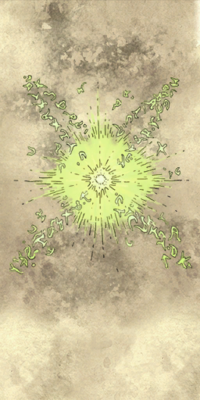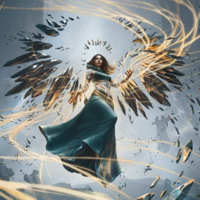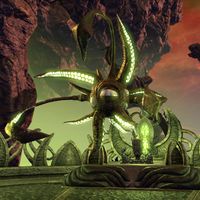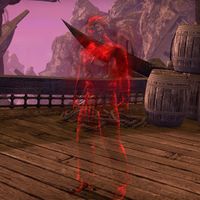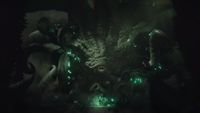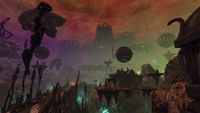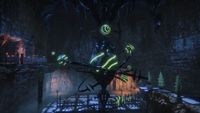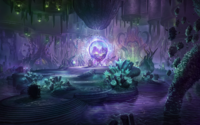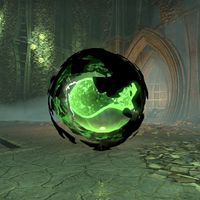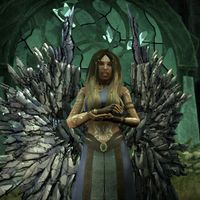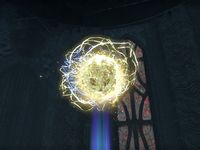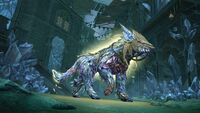Lore:Fate
Fate is a metaphysical concept which posits that events develop as determined by a higher power. While the nature and identity of the power that authors fate remain in contention, it is clear that fate is a present force within Aurbis and that certain deities such as the Daedric Princes Hermaeus Mora, Azura, and Ithelia have dominion over at least some aspects of it.[1][2][3][4]
Threads of Fate[edit]
The threads of fate are said to be the lines of possibility which weave through reality and hold all existence together[5], residing within all things and creating a complex tapestry which binds together all that exists.[6] They are said to form the tapestry of life and more,[7] and to weave all worlds together.[8] The patterns that fate's threads weave are said to be highly complex and specific, thus repairing them when damaged requires inestimable precision.[9]
Each individual has their own fateline, the tapestry of their fate made of up the many strands of the choices and events of their lives. The force of Fate, comprised of all the accumulated fatelines, is therefore visualized as either a loom that constantly spins out the threads of destiny, or as a vast ocean with currents and tibes that ebb and flow forever into the future.[10][1]
There are those who can perceive and scry the fate-threads in order to gain information, including the possible futures that might unfold and the likelihood of them occuring, the objects and beings tied to an event, where it might take place, and when a thread becomes frayed and when it is ultimately resolved. Particularly important events occuring somewhere can be sensed by those with the ability to perceive fate's threads as the threads surrounding a particular location being in disarray.[5][2]
This ability to perceive fate is known to exist among the Daedric servants of Hermaeus Mora, whose Watchers can discern future events ranging from the insignificant to cataclysmic disasters. Able to observe and locate contradictions and distortions in the fabric of fate, and to sense ripples and anomalies that alter fate forming even across the realms, they are tasked with discovering their cause and fixing them by repairing the fatelines and resolving any contradictions to fates recorded in Apocrypha, serving the Prince as "auditors of fate".[9] Especially powerful servants of Mora have been known to acquire detailed information about the fates and lives of those they encounter at a glance, witnessing the events that have happened, that might or may never happen, and even unwoven fates that one might've lived. Using the proper ingredients and summoning rituals, these Daedric agents of Mora can be bound to answer the questions of the one who invoked them.There are mortals who possess abilities to observe fate similar to those of Mora's agents, having been taught how to see fate's threads by the Daedric Prince himself. Such mortals can even share their gift with others, should they desire to.[11][12][13][5]Though highly useful, the ability to see fate's threads can sometimes be a hindrance, those who possess it can be made to feel great pain when near a severe enough distortion of fate, preventing them from even coming near locations where such a phenomenon is present.[5]
Though the threads of fate can be scried, many possible paths branch from each choice one makes, therefore knowing too much about what is to come poses a risk of changing the outcome. In addition, according to Hermaeus Mora, it is the nature of mortals to always have a chance to succeed and reach a desired outcome even when it would otherwise be impossible, a quality not possessed by immortal beings like himself who would inevitably fail in the same circumstances. Lastly, certain individuals like the Vestige and the Unseen, servants of the Daedric Prince Ithelia, have the ability to cause fate to warp around them and forge their own fate, and so their actions and their consequences can't be accurately predicted. Because of this even the ability to perceive fate's threads can't always accurately predict an outcome when such factors are involved. Even Hermaeus Mora acknowledges that, though as the One Who Knows and Ur-Daedra he can see the infinite possibilities of existence arrayed before his gaze, even he can't necessarily always see the "final path". [5][2][14] The unique ability of mortals to choose their own fate is also affirmed by the Daedric Prince Ithelia, according to whom mortals, unlike immortals such as the Daedra, possess the ability to change who they are and alter their own fates naturally, without the need of magic or divine power, something which beings such as herself or her servants are incapable of.[15] Though Daedra such as Hermaeus Mora and his servants can see the fate threads that weave all worlds together they can't read the contents of the Elder Scrolls, as the Ancestor Moths which represent the "endless Aedric coil of mortal souls", and thus a connection to the Aedra themselves through the experiences of every mortal who has ever lived, refuse to communicate with them.[8]
It is said that sufficient damage to the fabric of fate can endanger all of reality.[2] Forces that can influence fate can cause the threads to become tangled and form knots, disrupting and decoupling the bonds of cause and effect upon which existence is built. In such circumstances it becomes possible for a blade to swing through the air but refuse to cut, or town to erupt in flames without a single spark being struck. Should the force tangling the threads persist for long enough, the threads can snap, causing localized reality itself to collapse and erasing everything present from existence. While the task of locating and repairing contradictions and anomalies of fate is normally handled by the auditors of fate that serve Hermaeus Mora, there can come a point when a distortion of fate grows so severe it develops into a reality tear. Reality tears are holes in the fabric of reality itself, they are said to be the result of a piece of existence itself having been destroyed due to instabilities in fate, visible as rifts in space filled with nothingness, they will shred and destroy fate threads surrounding them, and erase from existence anything unfortunate enough to touch them. Unlike normal anomalies in fate, reality tears cannot be sensed directly even by the servants of Hermaeus Mora, their presence can only be guessed based on the effect they have on nearby fate threads, and their existence has to be confirmed directly through being near one. Once a fate distortion becomes severe enough for reality tears to start appearing, the rifts of nothingness will begin manifesting more and more across various locations and planes of existence, causing reality to crumble a bit further with each passing moment. Being the result of the unnatural manipulation of fate, reality tears do not disappear by themselves, they must be repaired through fate magic or they'll keep multiplying and growing until all existence is unraveled, a process likened to pulling on a loose thread until one's whole tunic unravels.[9][5] Though fractures in the threads of fate are invisible to most, it is said that those that manage to see them gain a reminder that fate isn't always immutable.[16]
The only known way to repair reality tears is through use of a spell originating from Hermaeus Mora himself. Casting the spell at nexus points in reality, locations which naturally resonate throughout the realms, and inserting energies opposite to the force that created the tears into the fabric of reality, allows for not only the local tears to be sealed, but for the event to resonate across Aurbis, beginning the restoration of all damage to fate, though completion of the process may take some time. Though incapable of repairing reality tears themselves, fate auditors can somewhat slow their spread, and users of fate magic can help the process of fate's threads being repaired further along when something that can repair them like Mora's spell is used.[9][5]
Unwoven Fates[edit]
For each strand that might become part of one's fate there comes a threshold, a point past which it either becomes inextricably woven into their fateline or is rejected from it, becoming an "unwoven" fate. These unlived fates are likened to paths unwalked, shadows one's life casts, or scattered debris it leaves behind, creating a chain that links back to its very first moment.[10]A severe enough distortion in fate can alter the fate one would have lived out, making it so that futures and fates that were meant to come to pass wink in and out of reality, or come to never be at all.[9]
Through the use of Magic it is possible to peer through the veil of reality in order to look beyond one's own life and into the unwoven fates one might've lived much like Hermaeus Mora and his agents can, allowing for the unwalked paths to be accessed in order to learn from them. Such magic can even allow for unlived fates to become "frayed" from the universe and become manifest within the world, a state in which they can be incorporated directly to gain the knowledge and power they represent. However, this phenomenon is highly dangerous, as frayed fates can develop their own awareness and seek to absorb their counterpart fates, or even replace their originator, themselves. Such aware fates can not be vanquished so long as the anchor that manifested them into the world remains. It is unknown where frayed fates are sent after being vanquished, but Azandar-al-Cybiades theorizes that such a place exists and is confident it's deeply unpleasant.[10][13][12][17]
Magic and artifacts that tap into unwoven fates can function and be enhanced through blood, as fates are blood-bound to an individual.[10][13]
Fate and Apocrypha[edit]
While the nature and identity of the force fate issues from remain in contention, the Daedric Prince Hermaeus Mora is said to have dominion over at least one aspect of fate. Described as the ever-seeing-eyes that constantly scry fate to see what is destined to happen next, Mora is likened to a great eye either suspended above or always submerged in fate's ocean, gazing into the depths to track the currents of fate. Thus he is called the "Master of the Tides of Fate", not because he controls fate, but because he knows its every possibility and outcome intimately, perceiving all that may come to pass. As the One Who Knows and Ur-Daedra, Hermaeus Mora is said to be able to see all the infinite paths of possibility arrayed before his gaze, though even he doesn't necessarily always know the "final path". This is also reflected in his realm of Apocrypha, which takes the form of an endless ocean of knowledge and secrets, though it's unclear if the idea of Mora as a vast entity cataloging the tides of fate or the shape of the realm came first, with one perhaps being just a reflection of the other.[1][2] Mora's reach and gaze even extend beyond the veil of reality and what is and into possibilities that may be or might have been.[10][13]
The currents of fate flow strongly in Apocrypha, a quality which makes the realm the ideal place for one seeking to understand the mysteries of fate and the Abyssal Sea, but also makes it highly dangerous, containing regions where it is possible for a traveler to become lost in fates that never came to pass, strange realities that can imprison the unwary in worlds of their own making. This holds especially true in certain regions of the realm like the Underweave, described as a powerful and dangerous nexus of fated potential, a locus of might-have-beens and never-will-bes, where fate shifts constantly like the tides of the Abyssal Sea and fatelines flex and fray.[13] [18][19]
Potent fates with the potential to influence the very fate of the planes are transcribed within crystalline artifacts called Glyphics, described as the physical manifestation of that potential fate or other knowledge which can be coaxed to transform into a tangible version of the concept they contain. Of those fated Glyphics, those containing fates which ultimately didn't come to pass are "uncatalogued" and unmade by being fed into the Nemesis Looms, devices that unravel parts of reality that reside in the Heart of the Underweave, as failed fates that aren't destroyed can latch onto reality and cause havoc. This process also serves to accumulate immense amounts of magicka, as the unmade fates are dissolved into arcane energies and "temporal dust", which the Heart than stores. It is suggested that through doing this Mora somehow "refills" the well of knowledge within Aurbis so it doesn't become exhausted, though Mora's servants refuse to provide more information. The power in the Heart can be tapped into to manipulate time, but doing so is highly dangerous as it can potentially cause realm-tearing temporal anomalies.[20][5][21]
Agents of Hermaeus Mora with the ability to perceive the threads of fate serve the Prince as fate's "auditors", given the task of seeking out distortions in fate that result when something that contradicts a fate recorded by Hermaeus Mora occurs and repairing the threads by discovering and addressing the cause. Once an important contradiction in fate has been resolved a summation of the associated events is recorded in the Chronicle of Apocrypha, where it is commemorated eternally. [9][5]
Apocrypha and Nirn are said to share a powerful connection, the fates of the two worlds are inextricably linked and, because of this and its role in regulating fate, were Apocrypha to be destroyed, the resulting ripples of fate would also unravel the mortal world, and the ensuing destruction would ripple throughout reality.[2][5]
Apocrypha contains sprawling facilities dedicated to scrying fate and storing prophecies. Within the Sidereal Cloisters, Daedric orreries chart the light and movements of the stars and celestial bodies to predict the future. These prohecies, the result of centuries of perfected fate-scrying and translating the stars, after having undergone a process of refinement whereby the pure unrefined predictions of the orreries are scried and sorted in the facility's Divinatory Forums, are inscribed into tomes stored in the Cloister libraries.The contents of the tomes can vary, ranging from less momentous predictions such as the changing of grain prices or the formation of new valleys by rivers, to primordial predictions that could cause dire consequences across all the planes if misinterpreted, such as realm spanning conflicts. Ever-changing prophecies that can be affected by the mundane and ordinary are recorded in the Loggia Infinitum section of the Cloisters, prophecies of dangerous events are kept in the Calamitous Gallery where the Cloister caretakers begin their study in order to test their resolve, and prophecies that predict the changing of regimes and dynasties are stored in the Empyrean Ascent. Due to their importance, Hermaeus Mora has been known to take direct action to prevent valuable tomes from leaving the Cloisters, on one occasion trapping the whole facility in a time loop to prevent a text from being lost.[22][23][2]
The function of the Infinite Archive, a subrealm of Apocrypha which lies within that realm's greater fabric and takes the form of an endless library that contains written records of events that were or could yet be from across Aurbis, revolves around a system of fateline manipulation. All objects and beings within the Archive are connected to an arcane orb known as the Index, which serves as both catalogue and safeguard. Threads of fate are spun between the Index and the contents of the catalogue and, when some sort of danger damages the recorded object and causes the fateline to snap, the Index restores the version of it from just before the break occurred, not a copy or recreation but the thing itself from a different moment in its fateline. The Archive contains tomes dedicated to recording information pertaining to possible outcomes, such as the Book of Infinite Questions and Potent Possibilities, in which all the potential questions one could ask at a given moment are recorded.[24][25]
The Unraveling Palimpsest, a tome of Apocrypha with contents that take a different form unique to each observer, allows its reader knowledge of any secret as long as it pertains to their own life and fate, thus "unravelling" the secrets of their fateline. It is actually a supernatural phenomenon formed in response to the realm's endless ocean of knowledge.[13]
Should the personal recollections of Hermaeus Mora stored within the Eyes of Mora somehow be altered, the event the memory depicts itself will be rewritten.[2][5][26]
One of the nexus points of reality which resonate throughout the planes, making it so that alterations to fate there ripple throughout existence, is located within the Watchling Grotto in Apocrypha.[9]
Fate and the Star-Orphans[edit]
While Hermaeus Mora is called the "Master of the Tides of Fate" and perceives all that may come to pass, he can not freely select which possibility comes to pass, as it is choice and chance which determine which outcome actually occurs. Contrasting Mora's sphere, the Daedric Prince Ithelia, Mistress of the Untraveled Road is said to possess the power to unravel the strands of fate and rearrange them to suit her every whim, shaping destiny itself to her liking. By her mere presence, even unwittingly, Ithelia can influence the threads of fate, causing them to tangle and knot together, or drag echoes of fates and beings from other realities to the reality where she resides, trapping them between worlds. When in control of her power, it is said that Ithelia possesses the power to shift existence itself and that reality and fate have to accommodate whatever she decides to do. According to Ithelia and her servants, while in her seat of Mirrormoor and using her Loom of the Untraveled Road, Ithelia can rewrite history and weave a new reality to suit her whims, unlock possibilities, undo mistakes, weave alternate versions of history from the Many Paths into reality to replace the history that exists, or even grant every single being that exists their own history comprised solely of things they desire. This power to alter fate is not without its dangers however, as through Ithelia exerting her power, anomalies in fate such as fate knots, and eventually even reality tears can form, endangering existence itself. When sufficiently enraged Ithelia can use this power to unravel reality itself around her, shredding existence until nothing remains. Though reality and fate have to shift to accommodate Ithelia's choices, they might shatter in the attempt to do so. For this potential to endanger reality, either willingly or as a side effect, Ithelia was given the title the Last Tomorrow, the prophesized destroyer of reality and a force which threatens the very pillars of causality upon which reality stands, by Hermaeus Mora. Due to the nature of her power, Ithelia's presence is said to untether all consequences, causing fate's threads in her immediate surroundings to seemingly vanish and so effectively disabling the fate sight of those who can perceive them.[2][5][26][15]
As a Star-Orphan of the Magna Ge before becoming a Daedric Prince, Ithelia, the White Star and Queen of Fates Unwritten, was said to dictate that fate have a chance to be born. Additionally, she is said to will that a Prisoner Unbound, beings that can forge their own fate, always exist.[3]
As a Daedric Prince, after Ithelia used her power to alter fate to avert a coming catastrophe, Mora examined her fate threads and perceived that Ithelia's power had already caused irreparable damage to the fabric of fate and that, if allowed to continue, her very existence endangered all of reality. Mora's fears intensified when Ithelia created her Loom of the Untraveled Road, a great fate altering engine via which she intended to tap into the power of the Many Paths and give every being their own desired history, breaking the shackles of fate. Believing that Ithelia's plans would result in the end of reality, Mora repeatedly confronted her to stop, but she refused to listen. Because of this Mora, Azura, Boethiah, and Mephala, warred against Ithelia and imprisoned her within the Mythos, the core of Apocrypha, after which Mora erased all memory of her existence from reality.[2][5][26][15][27]
Ithelia's Daedric servants, the Unseen, such as the Dremora Torvesard, also possess a degree of ability to manipulate the strands of fate. This allows them to accomplish tasks such as entering the Eyes of Mora without the corresponding key and even to alter the memories of the Prince contained there, thereby rewriting the event depicted itself. In addition this ability to influence fate has been used against enemies, be it to banish them to the Many Paths, casting them through both physical distance and realities, or to use reality tears to erase them from existence. They are not visible to the gaze of other Daedric Princes, even that of Hermaeus Mora, which is why they're called the Unseen, but their presence can be felt indirectly through the distortion they cause in fate's threads.[2][5][28][26][15]
Because of the ability they and their Prince possess to influence fate, the Daedra of Mirrormoor believe that there is no fate that can't be altered. To reflect this belief, they often wear designs of glimmering threads upon their skin, to remind themselves that one's fate and future are one's own making.[29] Mirrormoor Daedra believed themselves to be the owners of the Arcane Knot, a dangerous mystical object said to possess the power to connect the different realities, the Many Paths, to one another, treating them as if they'd never been separate to begin with, and even allowing one to cross over from one to the next. The Knot was long held within the Lucent Citadel in Fargrave, until a group of adventurers retrieved it for the Scribes of Mora, having defeated the Mirrormoor Daedra attempting to reclaim it.[30][31][32][33]
The Staff of Many Paths was a powerful artifact associated with Ithelia, capable of causing strange phenomena such as a novice soundly defeating an expert warrior or objects to disappear to take place around it. The Staff also possessed the ability to drain, hold, and imbue beings and objects with immense amounts of energy. After Torvesard, its last known wielder, was defeated, the artifact vanished in a flash of light and its fate is unknown.[28][34][35][36]
After Ithelia was exiled to a different reality, Mirrormoor and its denizens remained known, but Ithelia was erased from everyone's memory once more By Hermaeus Mora, her plane of Mirrormoor remaining as a shattered ruin, whose inhabitants are masterless. [37] Despite her banishment, the power of Ithelia and Mirrormoor continued to emanate across the threads of fate, marking some with its forbidden knowledge and leaving some among those who visited the realm changed. It is said that those touched in this manner could not recall who or what had changed them, retaining only dim memories of the event, like shards of glass scattered on the ground.[38][39]
The Star-Orphan Mnemo-Li, the Blue Star of the Nine Coruscations, is also said to be linked to endless possibility, frozen moments of unfettered destiny, rewritten narratives, including those of the Elder Scrolls, and the emergence of the Prisoners Unbound, as per the will of the Prime Archon, Ithelia.[3] Some texts credit Mnemo-Li as being the keeper of the Elder Scrolls.[UOL 1]
Fate and the Many Paths[edit]
The concept of fate is closely tied to the concept of the Many Paths, also called the Many Paths of Fate,[40] and the Many Paths of Time.[41] According to pre-Riddle'Thar Khajiiti myth, the Many Paths were created by Akha. Akha eventually disappeared and in his place appeared Alkosh, who took over the role of the First Cat, inheriting his crown and rule over the myriad kingdoms of Akha along the Many Paths. While he ruled over the children of Akha, Alkosh was soon overthrown and his body scattered on the West Wind. It was Khenarthi who flew along the Many Paths and put Alkosh back together, and now they both "safeguard the Many Paths from the wayward children of Akha".[42]
Described as the halo of possibilities and alternate fates that exists beyond and surrounding Aurbis, as well as the web which binds the possibilities scattered across Aurbis, each defined by unique choices and outcomes that lead to different realities, the Many Paths are said to lead everywhere. They are likened to a spiderweb that somehow formed within a diamond, interweaving lines within a grander fixed shape, or to a broken mirror where each shard is in itself a different mirror, a different reality. Different possibilities and probabilities, places where fate takes a different course, potentials not yet realized, alternate realities both near and far, all these exist along the Many Paths and can be accessed by those who can traverse the connections. It is said that within the Many Paths all things are possible, things which might not be real in one reality might be real within the Paths, it is even possible to encounter realities where concepts such as magic or Daedra might not exist, or realities that are a dark reflection of Aurbis, empty and timeless and filled with darkness, the world one sees when looking into a mirror. Each reality along the Many Paths contains its own version of each entity, be they mortal or Daedra, even deities such as the Daedric Princes have their own alternate versions within the realities. These alternate versions are said to be "reflections" of one another, different in some ways, like images in a cracked mirror, but originating from the same seed.[5][15][30][43]
As the Prince of Paths, Ithelia can perceive all the Many Paths at once. Though she can't outright control the Many Paths, she can travel between them, or follow their threads and reach out to alter their fates. All alternate Ithelias across the Many Paths are connected to one another, a connection strengthened when Ithelia imbibes the Sage's Dream, a brew formed from the essence of many of her "reflections" from different Paths, which allows her to incorporate knowledge and power from them. Ithelia can also share her perception of the Many Paths with others, allowing them to briefly view the Many Paths as she herself does.[15][2][5]
Through her power to influence the Many Paths, Ithelia is said to be able to reshape the fates. Using her Loom of the Untraveled Road, a series of portals within portals leading to the Many Paths, it is said Ithelia can access alternate fates and histories and weave them into reality to replace the history that exists. Ithelia's ultimate goal prior to her imprisonment was to use the Loom to give each being their own desired history and so break fate's shackles entirely.[15][5][28][26] Fearing that Ithelia's unnatural manipulations, which had already caused the Many Paths to splinter, would lead to the end of reality, Hermaeus Mora and three allied Daedric Princes took action to imprison her.[2]
Hermaeus Mora, like Ithelia, can perceive the Many Paths, and is even able to locate specific realities with the qualities he's looking for within them. Mora acquired the ability to open portals to other realities accessible through the Many Paths after Ithelia showed him how to do so. Through tapping into the possibilities of the Many Paths, Mora also possesses the seeming ability to restore to existence individuals who were erased via contact with a reality tear, though the Vestige theorized he might have simply pulled an alternate version of the erased individual from the Many Paths to give the impression he restored the original instead.[2][15][5]
Fate Magic[edit]

Though Hermaeus Mora's sphere, unlike Ithelia's does not include control over fate itself,[2] some of the Prince's agents have shown some limited ability to influence the threads of fate. In 2E 582, Leramil the Wise, an agent of Mora, used her magic to rearrange the threads of fate in order to force the entrance to the Infinite Panopticon to return to a location it had already moved on from, though doing so placed great strain on her. Later Leramil, Torvesard, and the Vestige who had been granted some ability to align the threads of fate by Mora due to their role as Fate's Proxy, worked together to align the lines and open the portal to the Mythos, the core of Apocrypha. While accompanying the Vestige Leramil influenced fate in order to revitalize and aid them in combat.[5][26]
Users of fate magic can also influence fate in other ways, such as aligning its threads to transform the forces of arcane objects into powerful magical artifacts, helping stich fate's threads together when they've been damaged, revitalizing an ally in combat, or shielding from spells involving the manipulation of fate such as spells to banish someone to the Many Paths.[5]
Scruut, a Watchling fate auditor in the service of Hermaeus Mora, believed that influencing fate the way Leramil did was a power not meant for mortals, and that using it would prove her undoing one day.[9]
The Psijic Order had the means to scry secrets from fate lines beyond the bounds of Tamriel. Among these secrets were tomes that spoke of alternative timelines and realities, where certain key events transpired differently, resulting in drastically different fates for those worlds.[44][45][46][47][48][49]
It is said that those who pluck the threads of fate can shape the moment as they will.[50]
Artifacts[edit]
The Unraveling Palimpsest[edit]
The Unraveling Palimpsest was an arcane tome of Apocrypha the contents of which transform depending on the reader, taking a form unique to each. In actuality a manifest supernatural phenomenon created in response to the endless seas of knowledge within Apocrypha, the tome allows its reader to learn any secret as long as it pertains to their own life and fate, in essence "unravelling" the secrets of their fateline. In 2E 582 Azandar-al-Cybiades delved into Quires Wind, a facility in Apocrypha where the tome was stored, and used it to discern which defining moments of his life anchored the Adversary, a frayed fate intent on absorbing its alternate fates and replacing its originator, to him.[13]
The Fateweaver Key[edit]
The Fateweaver Key was a powerful key shaped artifact created by Azandar-al-Cybiades, an exceptionally skilled Arcanist and mage of world-class power and knowledge said to be comparable to that of Morian Zenas, after a lifetime of research and experimentation. The Fateweaver Key was created in order to allow Azandar to replicate the ability of Hermaeus Mora to gaze beyond the veil of reality, allowing its wielder to observe his unwoven fates, the "might have beens" of his life, for knowledge. The Key, however, exceeded its creator's expectations, causing his unlived fates to become "frayed" from the universe and become manifested within the world. During his efforts to track down these frayed fates and use the Key to "stitch" them back into the universe Azandar encountered the Adversary, a hostile frayed fate that sought to absorb its counterparts and take his place using its own version of the Fateweaver Key. As the Adversary could not be vanquished as long as his anchor to the world, the Fateweaver Key itself, remained, Azandar instructed the Vestige to burn the artifact out using a font of Magicka and the Adversary was banished. Acknowledging the danger and temptation the Key represented, Azandar elected to have the now inert relic cast into the ocean.[13][51][17][12]
The Loom of the Untraveled Road[edit]
The Loom of the Untraveled Road Daedric apparatus of unimaginable power said to be what Hermaeus Mora feared, leading to him taking action against Ithelia. Described as a series of portals within portals leading to the Many Paths, it is more of a place than an engine, residing within a pocket dimension within Fargrave. With the Loom Ithelia is said to be able to reshape the fates, accessing alternate fates and histories from the Many Paths and weaving them into reality, or even granting each being their own desired history to break fate's shackles. Places that were part of Mirrormoor are said to be fundamentally connected to the Loom, and artifacts used in such locations will have their power drained by the Loom as it gains power. Through the Loom Ithelia can also draw immense amounts of power from the Many Paths, though the untold amounts of energy ultimately overwhelm her, transforming her into the Last Tomorrow, the threat Hermaeus Mora foresaw. Even after being destroyed through the use of Boethiah's Blade, Abolisher, the Loom still radiates power, preventing approach through portal magic and making the area around the Loom itself unstable, threatening anyone lingering there with the possibility of becoming lost in the Many Paths.[15][5][28][26]
The Arcane Knot[edit]
The Arcane Knot is a dangerous and deeply unstable mystical object of incredible power. It is said that if reality can be thought of as a great glass mirror than, when that mirror breaks, the result is many mirrors, many realities. The Arcane Knot is said to possess the power to treat the mirror as if it never broke, to connect the different realities and even allow one to cross over from one to the next.[30] The Knot's influence can have various effects such as granting the one holding it incredible power, causing the size of their physical form to increase, or spawning Glass Atronachs, but it is deeply volatile and will eventually consume the holder and everyone around them, infusing them with Temporal Splinters that build up into a destructive Arcane Fracture, and draining and eating away at them until they disappear into the Knot itself.[30][52][53][54] It is said that even momentary exposure to the Knot can cause one's very animus to shatter and thus surviving in its presence for any period of time is impressive.[32] For a long time the Arcane Knot was held deep within the Lucent Citadel in Fargrave, its origin and intended function were completely unkown[32] and even among Fargrave's Daedra there were only a select few that could remember the citadel[55]. In 2E 582 an expedition of Mirrormoor Daedra attempted to retrieve the Arcane Knot, as their leader believed it belonged to them. A group of adventurers defeated the Daedra and retrieved the Arcane Knot, surviving its influence long enough to contain its chaotic power within the Null Arca, a Daedric device created to supress dangerous magical objects. With the potential calamity the Mirrormoor Daedra could've caused with the Knot prevented, the contained object was taken away for study by Scribes of Hermaeus Mora.[30][31][32][33]
The Staff of Many Paths[edit]
The Staff of Many Paths was a powerful artifact associated with the Daedric Prince Ithelia and filled with her power,[43] which had the ability to drain, hold, and imbue beings and objects with energy. The Staff was long guarded by the Oathsworn, followers of Malacath within their training ground of the Oathsworn Pit, until it was stolen by the Recollection, a Bosmeri cult that revered Ithelia. It is said that around the Staff strange things would often happen, weapons going missing, or initiates somehow thrashing a veteran trainer during their first lessons, causing the relic to be locked away.[56][57] The Recollection would use the Staff to imbue the Greensprig Seeds which Greenspeakers normally use to grow new sections of forest with Daedric energies that strengthened and corrupted the magic, creating Wildburn Seeds which they used to cause a thick jungle to cover much of the West Weald overnight, and to create the Wildburn, a magical corruption of the land that mutated living beings. The leader of the Recollection, King Nantharion, attempted to use the Staff to create a new Wildburn Seed, but the interruption of the ritual by the Vestige caused the Seed's energies to be released prematurely, destroying the Recollection's living fortress of Hoperoot. [58][59][34][60][43][61] At Miscarcand Nantharion attempted to use the Staff to drain the energies of the great Ayleid Well in order to restore Ithelia to her ancient power and create a Wildburn that'd cover all of the West Weald. Though Nantharion was slain, the servants of Ithelia retrieved the Staff and channeled the Well's power into her, restoring her ancient might.[60][43][28][35] The Staff was last seen during Ithelia's attempted takeover of Apocrypha, wielded by Torvesard, who used the artifact to drain the power of Hermaeus Mora and imbue Ithelia with it. After Ithelia was granted clarity by the Mirror of Truth and decided to put an end to her plans, a desperate Torvesard turned the Staff on his Prince, absorbing the combined power of both Ithelia and Hermaeus Mora into himself and imprisoning both. Torvesard used the Staff to channel his power in battle. After Torvesard's defeat the Staff vanished in a flash of light and the stolen powers were returned to their respective Princes, the artifact's fate is not known. [26][15][36]
Gallery[edit]
Notes[edit]
- Qualities that resemble the ability of Hermaeus Mora to perceive all of fate's possible paths and outcomes are also attributed to a number of other gods. These include Alkosh who, like Khenarthi, is said to be able to see across all the Many Paths of time.[41]. Jyggalag whose library is said to have contained accurate predictions of every event and every action ever taken by any creature be they mortal or Daedric, based on formulae of logical deduction.[62] And Sotha Sil, who is likewise described as able to make accurate and detailed predictions of how events will unfold long in advance through simulations.[63][64]
References[edit]
- ^ a b c Master of the Tides of Fate — Leramil the Wise
- ^ a b c d e f g h i j k l m n o Hermaeus Mora's dialogue in ESO
- ^ a b c The Nine Coruscations — Star-Queen Varalias
- ^ The Anticipations — Anonymous
- ^ a b c d e f g h i j k l m n o p q r s t u Leramil's dialogue in ESO
- ^ Threads of Mirrormoor Body Art in ESO
- ^ Fate Strand Harvest description in ESO
- ^ a b Loremaster's Archive - Elder Scrolls & Moth Priests — Sister Chana Nirine
- ^ a b c d e f g h Scruut's dialogue in ESO
- ^ a b c d e The Never-Woven text in ESO
- ^ Predestination and Paradox: A Treatise text in ESO
- ^ a b c Tem's dialogue in ESO
- ^ a b c d e f g h Azandar-al-Cybiade's dialogue in ESO
- ^ ESO Twitter Hermaeus Mora Roleplay
- ^ a b c d e f g h i j Ithelia's dialogue in ESO
- ^ Replica Fate-Thread Fracture description in ESO
- ^ a b The Adversary's dialogue in ESO
- ^ The Underweave loading screen in ESO
- ^ The Doom of the Hushed — Leramil the Wise
- ^ Ogle's dialogue in ESO
- ^ Thaddeus Cosma's dialogue in ESO
- ^ Meenai-Shai's dialogue in ESO
- ^ Morbid Observer's dialogue in ESO
- ^ Loremaster's Archive - Infinite Archive — Master Malkhest
- ^ Master Malkhest's dialogue during the quest The Margins of Ire in ESO
- ^ a b c d e f g h Torvesard's dialogue in ESO
- ^ Adept Rakzzin-jo's dialogue in ESO
- ^ a b c d e Shardmarshal Vargas' dialogue in ESO
- ^ Threads of Mirrormoor Face Art in ESO
- ^ a b c d e Keshargo's dialogue in ESO
- ^ a b Neletai's dialogue in ESO
- ^ a b c d Scribe Nairoline's Letter in ESO
- ^ a b Events of The Knot Awaits in ESO
- ^ a b Events of Seeds of Suspicion in ESO
- ^ a b Events of King Nantharion's Gambit in ESO
- ^ a b Events of Fate of the Forgotten Prince in ESO
- ^ Discussion with Hermaeus Mora during In Memory Of in ESO: Gold Road
- ^ Mirrormoor Memory Body Marking description in ESO
- ^ Mirrormoor Memory Face Marking description in ESO
- ^ The Bladesongs of Boethra, Volume V — Modun-Ra, the Hidden Voice
- ^ a b Ja'darri's dialogue in ESO: Dragonhold
- ^ The Wandering Spirits — Amun-dro, the Silent Priest
- ^ a b c d Beragon's dialogue in ESO
- ^ Tracker of Temporal Tomes achievement description in ESO
- ^ Coral Aerie Temporal Tome — Varallion
- ^ Karnwasten Temporal Tome — Raavarion, Former Sapiarch of Aquatic Malevolence
- ^ Traitor's Vault Temporal Tome — Rullinalion
- ^ Vault of Moawita Temporal Tome
- ^ Garden of Sacred Numbers Temporal Tome
- ^ Fate Strand Harvest description in ESO
- ^ Meet the Character - Azandar al-Cybiades — Elydrina Nathriin
- ^ Neletai's Notes in ESO
- ^ Seeker Manadra's Expedition — Mercator Ambustus
- ^ Arcane Knot's description and function in ESO
- ^ Journal of Melus Marsicus in ESO
- ^ Dulzush Forgefire's dialogue in ESO
- ^ Events of Victory Through Strife in ESO
- ^ Greenspeaker Darolith's dialogue in ESO
- ^ Greenspeaker Sorilen's dialogue in ESO
- ^ a b King Nantharion's dialogue in ESO
- ^ Tribune Alea Idolus' dialogue in ESO
- ^ Dyus' dialogue in Oblivion: Shivering Isles
- ^ Sotha Sil's dialogue in ESO
- ^ Sotha Sil's dialogue in Legends
Note: The following references are considered to be unofficial sources. They are included to round off this article and may not be authoritative or conclusive.
